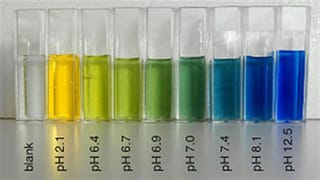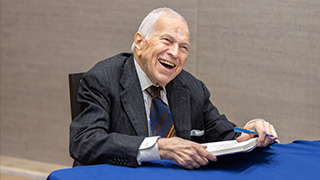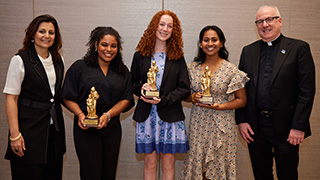Rose Mercadante Chemistry Seminar Series - DNA Conformation
Tuesday, October 10, 2017

The seminar will be held on Tuesday, October 17, 2017 from 5:45 – 7 p.m. in the Helen Lerner Amphitheater, Science and Technology Center, Seton Hall University. Refreshments are available at 5:30.
The conformation a particular DNA segment assumes depends upon its sequence context and the environment under which it is prepared. To complement our findings with G-rich sequences related to the human telomere, we have been investigating the pH induced transition from single strand to i-motif for sequences related to the human telomere C-rich strand. Initially, we studied the single strand to i-motif transition using DNA oligomers of sequence (CCCXXX)4, where X = A and /or T, as the pH decreases from 7.0 to 5.0 at 25 oC and 115 mM.K+. The pH at the midpoint of the transition is dependent upon loop sequence context. We then carried out titrations of (CCCTAA)4 from pH 7.0 to pH 5.0 at temperatures ranging from 15 to 45 oC at 115 mM K+ and at K+ concentrations ranging from 15 to 315 mM at 25 oC. Circular Dichroism (CD) spectra were determined to monitor the transition. The pH at the midpoint of the proton induced transition, pHmp, is also dependent upon both temperature and [K+]. Wyman type plots of log K vs pH yielded linear correlations and the slopes of those lines, Q, were also linearly dependent on [K+] and T. For these studies, Q represents the minimum number of protons that must be added to the oligomer to induce the initial folding. Optical melting studies were also carried out for (CCCTAA)4 at pH 5.0 and [K+] ranging from 15 to 315 mM. Linear correlations between the temperature at the midpoint of the transition, Tm, and log [K+] allowed determination of the differential ion binding term, nK+. These linkages between sequence, pH, temperature and [K+] can be utilized to design i-motif forming DNA oligomers with highly tunable properties.
Richard D. Sheardy was born in Lake Orion, MI and received his BS in Chemistry Education at Michigan State University. After earning his PhD in organic chemistry at University of Florida, he had a Post Doctoral Fellowship in biophysics at University of Rochester. Sheardy began his academic career at the Hazleton Campus of Penn State University and then went to Seton Hall University where he initiated his research on DNA conformation and stability. At Seton Hall, Sheardy mentored sixteen PhD students. In 2006, Sheardy moved to Texas Woman’s University where he is currently Professor and Chair of the Department of Chemistry and Biochemistry. He teaches freshman and biophysical chemistry and continues his research focusing on the structure, stability and ligand binding properties of unusual DNA conformations such as the G Quadruplex and the i-Motif. Sheardy is Conference Chair for the North American Calorimetry Conference and is a SENCER Leadership Fellow and has organized many symposia at regional and national conferences on nucleic acid biophysics and science education reform.
The Department of Chemistry and Biochemistry offers BS, MS and PhD degrees with specializations in all areas of chemistry. Our unique research environment, including traditional full-time students and part-time students is designed to foster collaborations with industry and colleagues in other disciplines. The Rose Mercadante Seminar Series is named for Rose Mercadante, the departmental secretary for over 40 years, in honor of our alumni, her "boys and girls."





